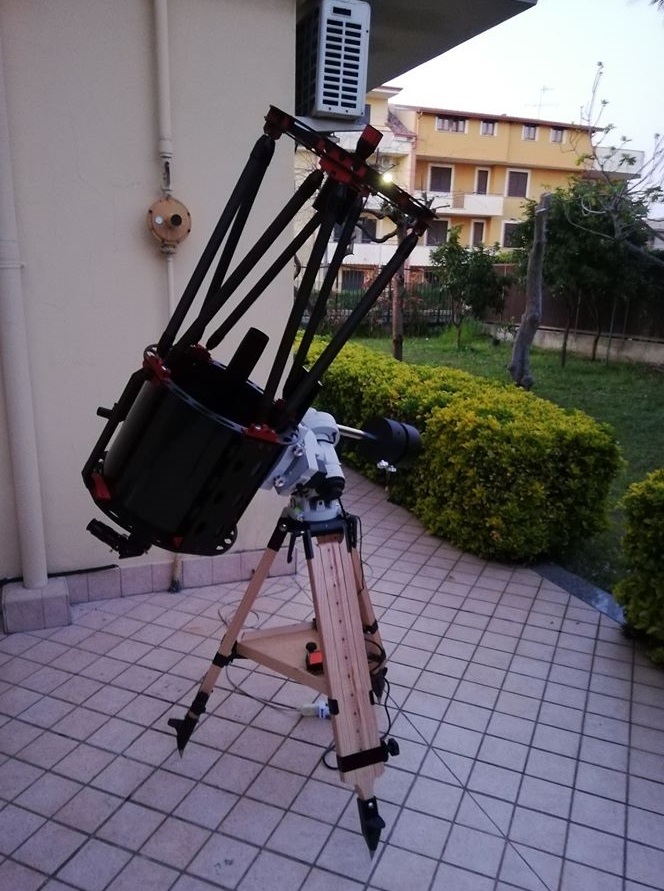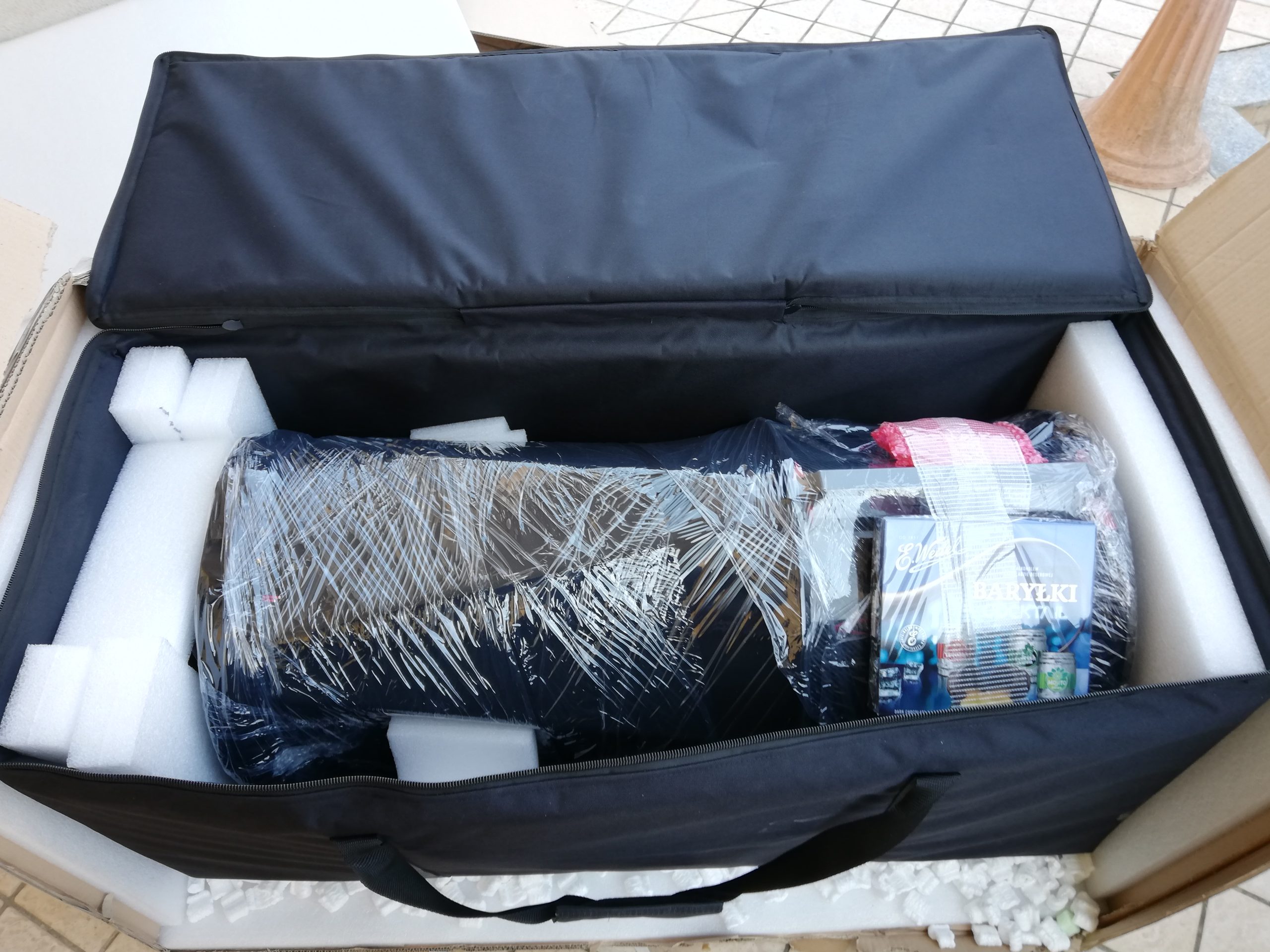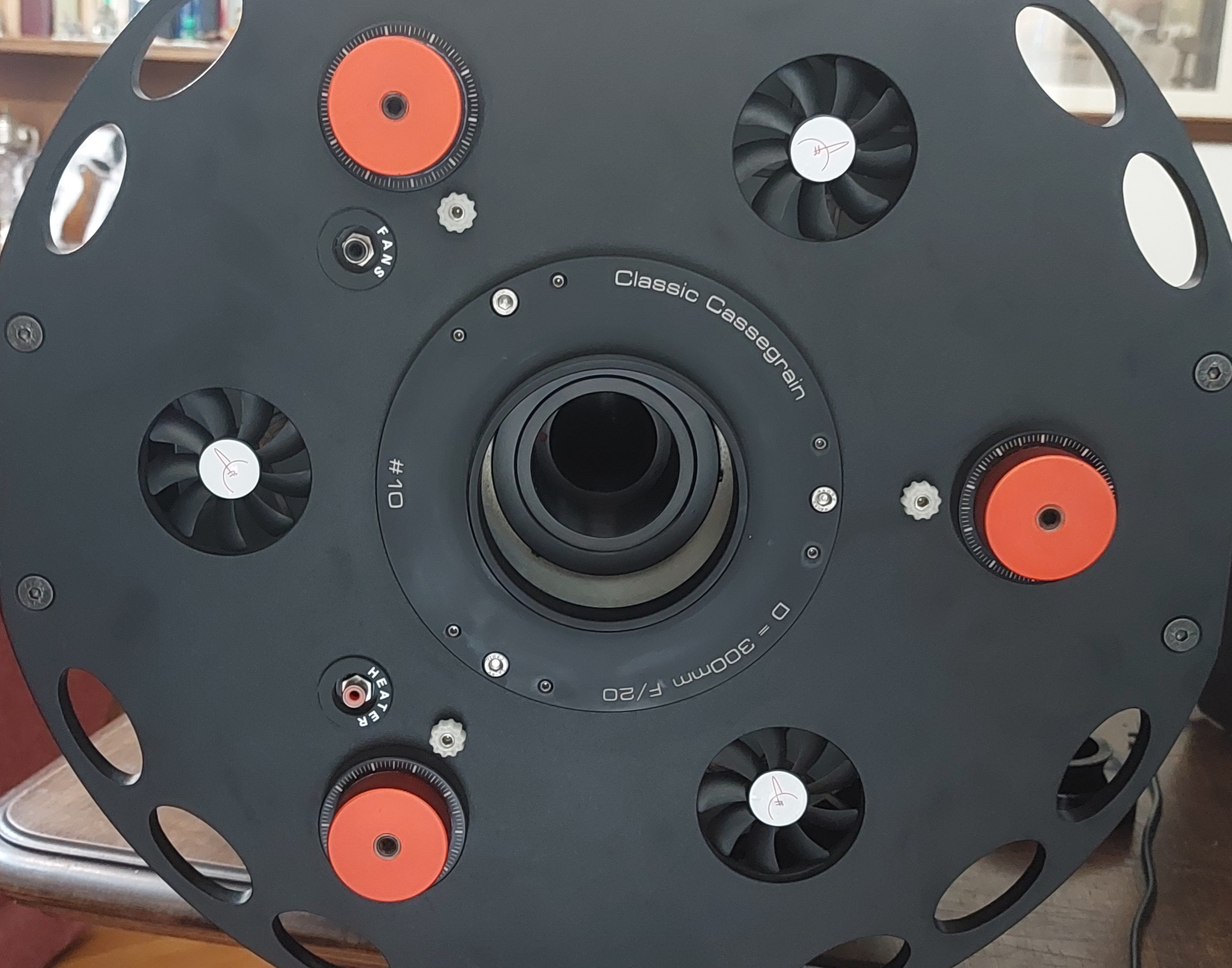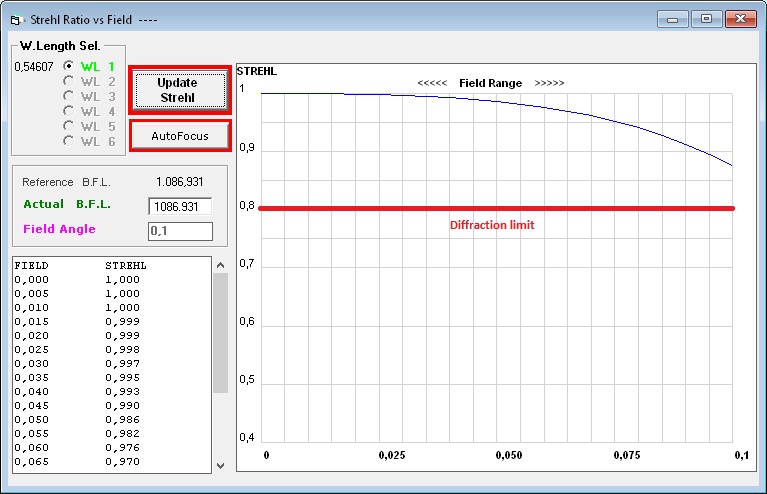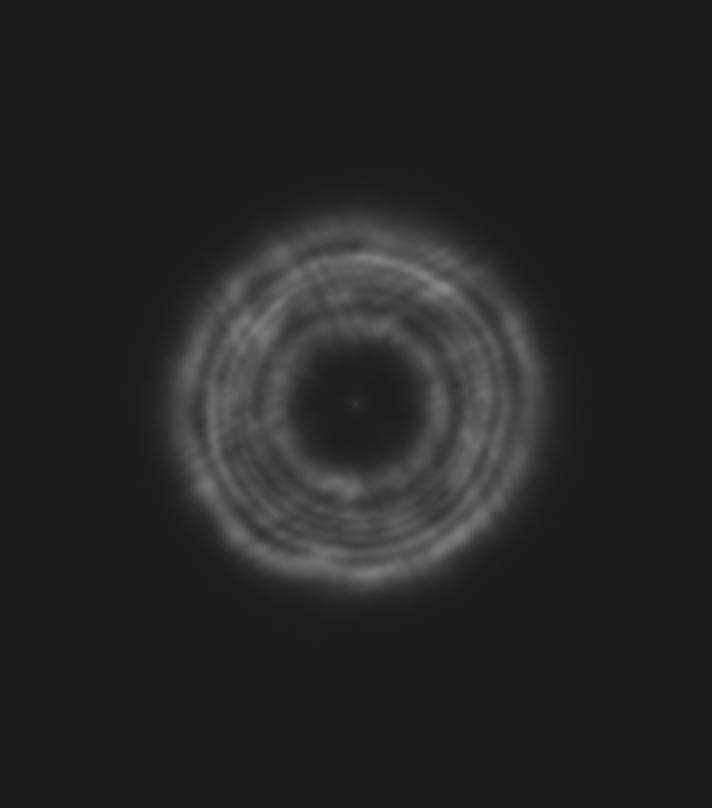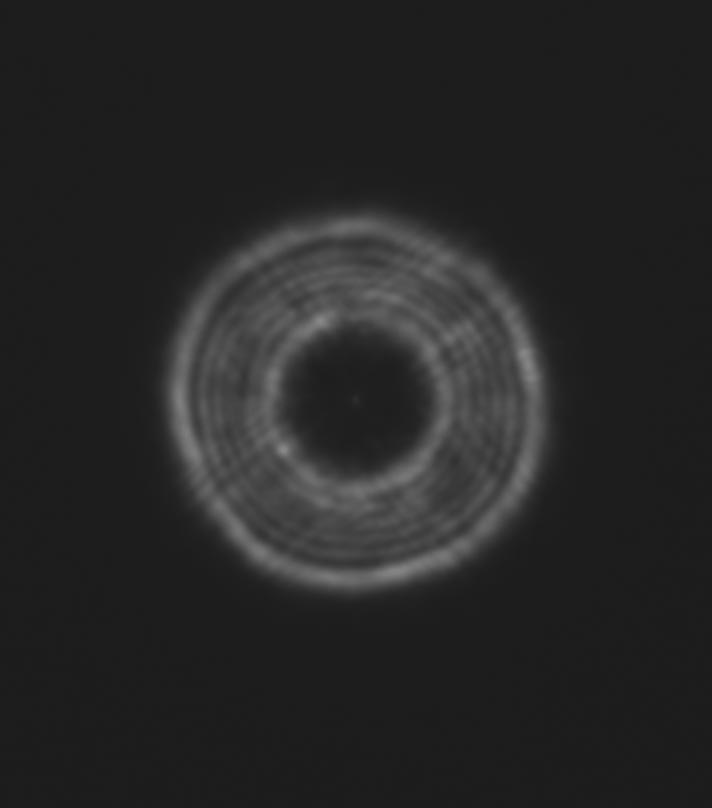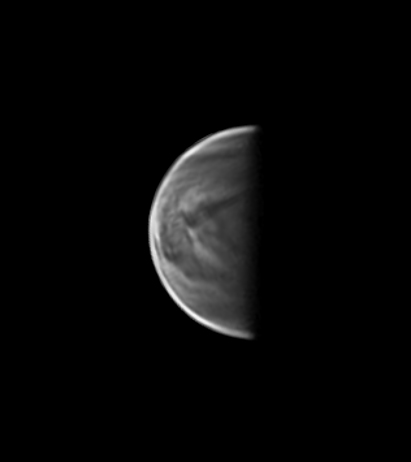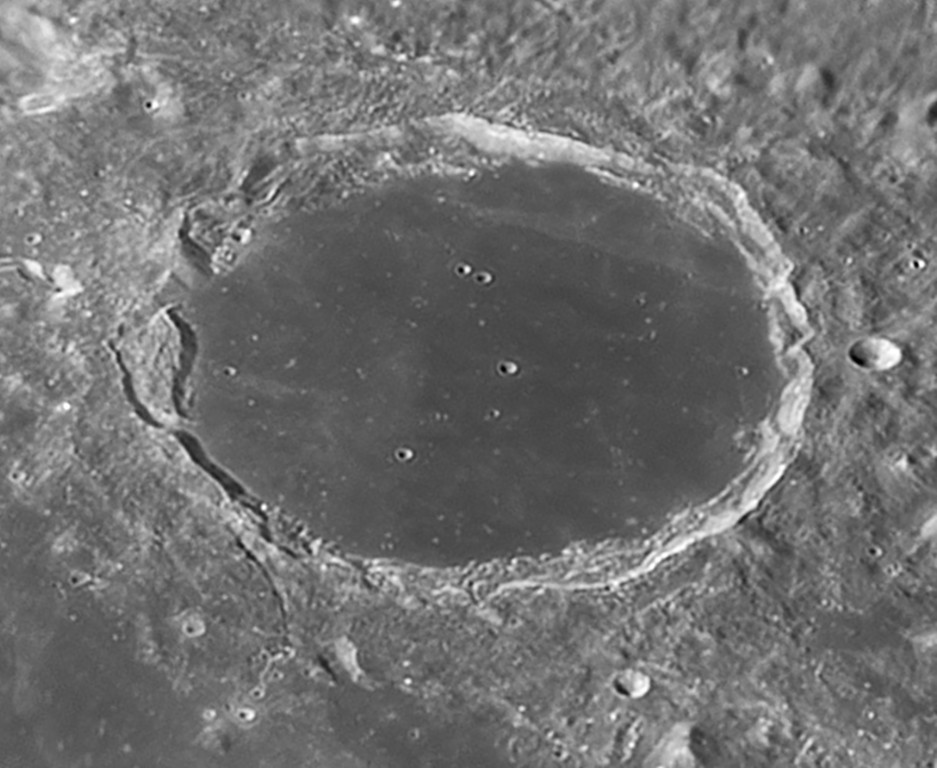The 30cm f/20 Classical Cassegrain by CFF is a classy instrument, intended for lovers of high resolution with refined tastes. The focal ratio, slowed to f/20 to minimize coma, makes this OTA a "little brother" of the legendary T1M of the Pic du Midi: a classic 1m f/17 Cassegrain, refigured by the great Texereau himself and placed at 3000m altitude in the French Alps, with which important pages of planetary astronomy have been written. The optical setup chosen for the CFF guarantees a diffraction limited field equal to more than 12 arcminutes (compared to just 1' for a 30 cm Newtonian with the same primary). This telescope therefore does not need any coma corrector, and, typically, not even a Barlow.
The large diameter, although not huge, guarantees excellent resolving power (0.4″) and a light grasp approximately 3600 times equal to that of the human eye (visual limiting magnitude around approximately 16, under average dark skies).
Optical design, weights and size
The primary is an f/3, to make overall dimensions (1030 x 410 x 450 mm, L x W x H) and obstruction quite small. The latter in fact is unusually low for a Cassegrain: just 25% . It should be noted that this value includes the very thin (0.8 mm) M2 spiders of the secondary and its baffle, and not simply the diameter of the secondary as is sometimes seen - incorrectly - around, in order to declare a value lower than real. The secondary mirror has a magnification of 20/3=6.66, which has practical implications on backfocus as we shall see below.
The scope is provided with a primary in Supremax33 (thickness approximately 1/8 of the diameter), but nobler (and more expensive) substrates are also available on request, such as quartz or ULE glass (Zerodur/Clearceram), while the secondary is made in quartz. The materials used for the trusses and primary cage are carbon fiber and aluminum alloy, capable of keeping weights under 20 kg (the weight of a C14). Design is attractive, with well-made finishes, as expected from an instrument of this quality. It is possible to choose between two colours, red and blue, and a "solar" version is also available, of course white, and with a non-aluminized primary mirror. The primary cage is internally fliocked with black velvet, which together with the long primary baffle avoids as much as possible from reflections in the eyepiece. The velvet used was very absorbent, as I found by comparing it with the barrel of an eyepiece painted with Musou Black under the light of a torch. Some design choices (as well as the statements of the manufacturer) confirm that the telescope is designed not only with imaging in mind. The limited obstruction and the large diffraction limited field guarantee pinpoint stars up to the edges of the field with all the 1 ¼” eyepieces I have used, including the 24 mm Panoptic. I have not tested the 2" eyepieces extensively, but the CFF guarantees the same visual performance (it must be said that the correct field of approximately 25 mm is lower than the field stop of a 2" eyepiece, so resulting aberrations are pretty much invisible to the eye). The only accessory that the visual observer really needs with this CFF is a diagonal: the optical train is reduced to a few things, with all the imaginable advantages.
The levers of this OTA are bigger than those of the SCTs. This translates into greater weights, for the same diameter, but also into easier balancing on the declination axis. The CoG (center of gravity) is in fact placed much more forward than that of the Schmidt-Cassegrains (in which it is very close to the rear cell, forcing the use of additional weights on the bar) allowing an easy placement of the tube on the saddle.
The rear cell includes three cooling fans, which have not shown to trigger vibrations when in motion even at very high magnifications (1000x, easily reachable with a 6 mm eyepiece), allowing them to be kept on even during observing sessions. A dew heater for the primary mirror is provided as standard, (powered like the fans by an RCA cable), which to be honest I have never had to use. The focuser supplied is a luxurious 2″ Feather Touch from Starlight, which I had replaced with a motorized Moonlite Hi-res, more suitable for me in imaging sessions.
Overall, it is a scope that mechanically gets to the point, and from this point of view it does its job well. The decidedly low weights should be highlighted as one of the best qualities (the writer lifts it quite often on the equatorial without external help).
Collimation and tuning
The adjustments are distinct for primary and secondary mirror. Anyone who purchases such scope should know (and generally knows) that this optical scheme is less tolerant than others (Newton, SCT, DK), and it is therefore good to be informed before attributing optical defects that have their cause elsewhere to the glasses. The necessary operations will soon become automatic, and, I dare to say, even pleasant. Once tamed, the instrument will repay us with first-rate performance and, at the eyepiece, with priceless emotions.
To adjust the inclination of the primary there are three large knobs on the rear cell, very hard to move, and also equipped with a graduated scale, plus three long locking screws with knobs. From the primary cell (with 9 support points) you can access three small tangential Teflon grains to avoid micro-shifts; with all these constraints it is easy to imagine how, despite its limited weight, the telescope maintains collimation well from one end of the meridian to the other, as I have verified many times. Some small adjustments may be physiologically necessary between summer and winter (due to different dilatation of the parts) or if best performances is desired (imaging).
The good engineering behind the OTA is proven, amoong other things, by the primary cage, well oversized compared to the diameter of the mirror (approximately 1 inch more), to the full advantage of temperature equilibrium reaching. The edge is masked by a plastic ring, held in place by three perimeter screws.
The secondary mirrir also has three screws for collimation, one of which is fixed, and a knob for axial movement. This graduated knob allows fine adjustment of the distance between the mirrors (1 turn = 1 mm of movement) and consequently the backfocus, which is abundant (35 cm, calculated from the center of the primary), allowing you to accommodate even the most complicated trains of accessories. Ordinarily, however, it will be necessary to use spacers to reach the focus. A threaded metal ring locks the secondary in its seat and, at the same time, has the purpose of masking the edge, a frequent site of optical defects. My fears about the lack of coaxiality of the secondary travel turned out to be unfounded, having found no trace of coma or astigmatism in the star test for excursions of a few mm in both directions.
Although it is advisable not to move the mirrors too far from the design value (no more than a few mm), the slow focal ratio allows ample room for adjustments, without introducing significant aberrations as happens with other faster Cassegrains such as Ritchey-Chrétien, in which even small deviations are paid with large spherical aberration. On this aspect I carried out extensive tests on the instrument using star tests, never detecting anything significant.
The large magnification of the secondary mirror (6.66x) translates into a rather exaggerated sensitivity of the backfocus to the distance between the mirrors. In fact, just one millimeter of movement of the secondary is equivalent to 4.5 cm of variation in the BF, which shortens if the secondary moves away from the primary or lengthens in the opposite case. It is unlikely that you will need all this focus range, even more so it is always good to stick to the design distance between the mirrors, indicated by a red spot inside the primary baffle. This fundamental distance is calculated to the millimeter for each OTA, and reported in the documents provided by CFF upon purchase. In my case, it is equal to 702 mm.
It goes without saying that every time the distance between the mirrors is changed, the instrument undergoes variations in focal length, and this must be taken into account in certain works where precision is required (such as astrometric ones).
The Cassegrain collimation is a topic already covered on this site in relation to its smaller 8" brother, whose review should be referred to for general considerations. The greater length of the CFF compared to the GSO actually makes it quite difficult to identify with the cap alone (and therefore with the naked eye) the very small cross that marks the geometric center of the secondary to the hundredth of a mm, making the use of the Takahashi collimator more convenient, unfortunately a rather expensive device.
As a final caveat, it is good to keep in mind that the two locking rings (the one of the secondary, and the one of the primary at the base of primary baffle) must be tightened moderately but firmly, otherwise astigmatism will arise. If you work on the rings for some reason, some tests on the sky will suggest the right moment to apply.
Optical performance
The manufacturer, in the attached interferometric test, claims a Strehl ratio of 0.97 in green light, and a wavefront correction around lambda/6 PV.
I performed several star tests and Roddier tests of the instrument, all of which showed very limited SA (which was my main concern). The amount of astigmatism, also very modest, was however variable, and I attributed this to some unspecified thermal effect, while some defect could possibly be also in the glass.
About star testing, it is wise to remember the words of A. E. Douglass, who was W. Pickering's assistant and carried out extensive studies on astronomical seeing: our instruments are way better than their atmospheres, which must lead us to remember the great sensitivity of the test, and not to go crazy chasing the chimerical, perfect equality of the two extrafocal figures. On the other hand, it should also be recognized that the test must be performed correctly, i.e., typically, very close to the focus (no more than 10 or 15 interference waves). Only in this way do we have a clear image of the wavefront, while by further defocusing we obtain an image of the entrance pupil, i.e. of the telescope objective and the secondary with its supports. Large distances from the focus are only useful when looking for specific defects, such as zonal ones.
It should also be emphasized that the optical design chosen by CFF is rather extreme, given that even the best opticains almost never go below f/4 for the focal ratio of the primary (and the aforementioned Texereau, in his seminal work How to make a telescope, says that a first-rate optician is already needed in this case).
As for the Roddier test (carried out using the WinRoddier software), my many tests showed that it was always quite dependent on the conditions in which the test was performed (for example on the defocus), with a variability in the Strehl of up to 0.05 units. This was also confirmed for the two measurements performed to test the Cassegrain, which I attach for the sake of completeness and transparency; for the test with the highest result I also include the complete screenshot. For greater accuracy, an average should be taken over a significant sample of measurements (which, if done well, are rather long and tedious).
The telescope in its original packaging, with a nice gift. The bag must be purchased separately
The rear cell of the telescope. This model is the 10th manufactured by CFF of its type.
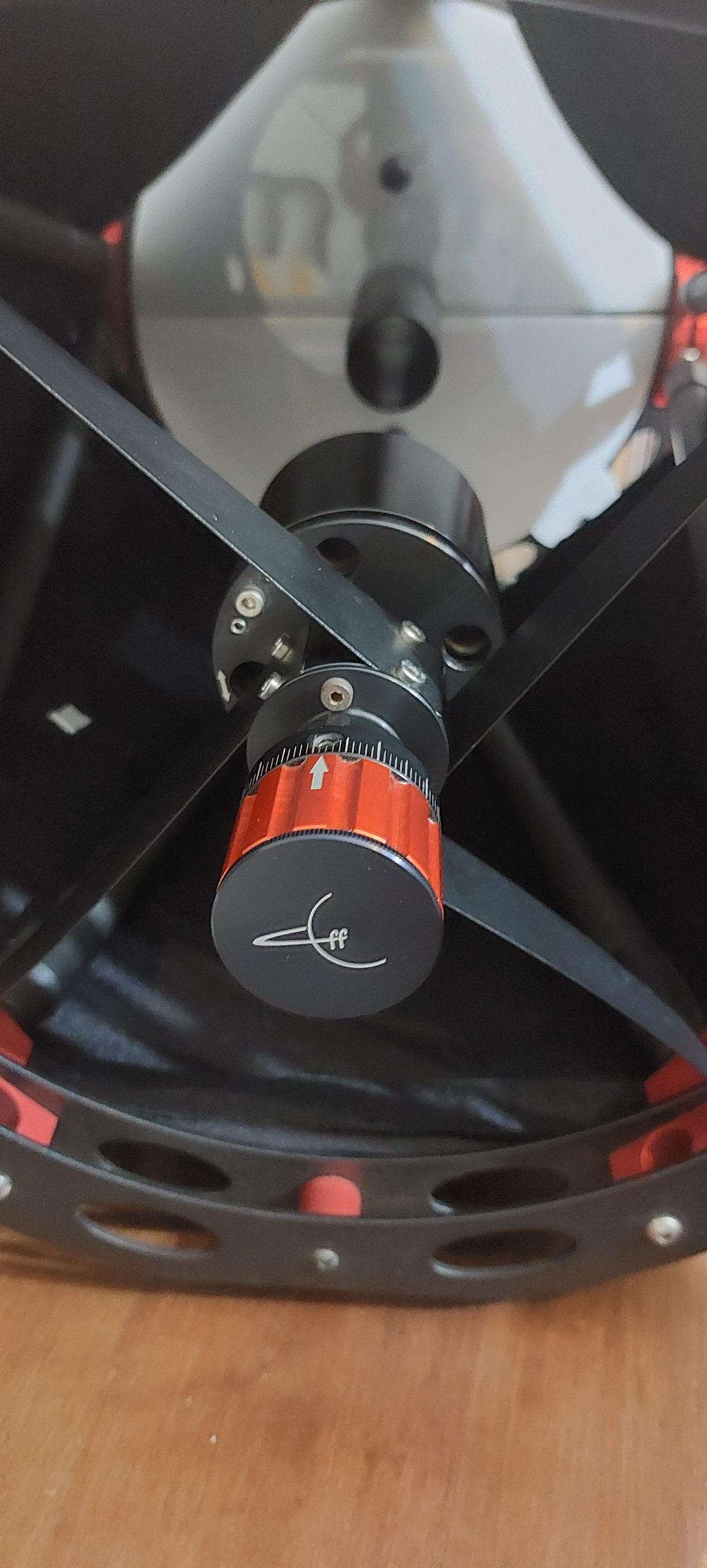
The nice-looking knob for axial adjustment of secondary and the thin spiders. Visible in the background are the two semicircular caps that cover the primary
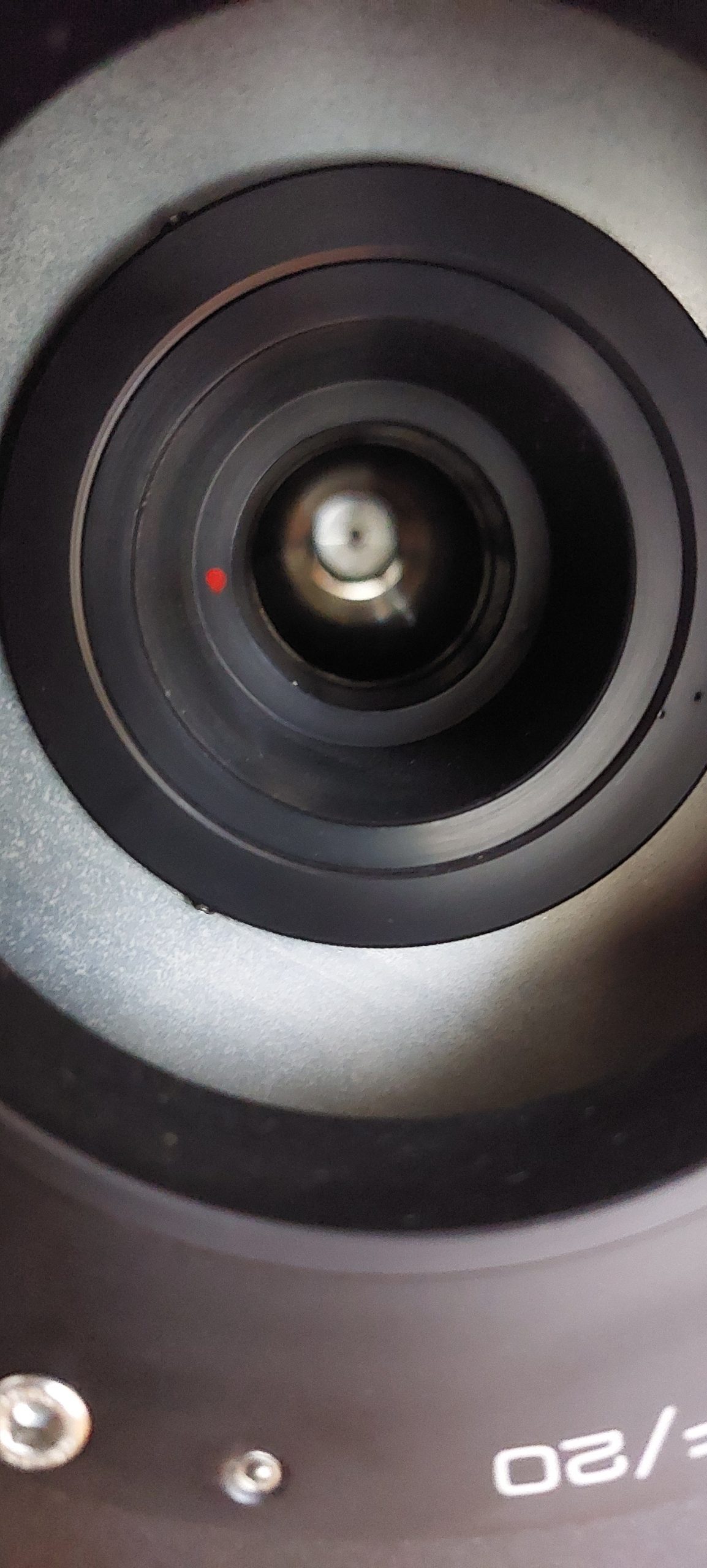
The red dot inside the primary baffle is given as a reference to calculate the design distance between the mirrors
Strehl ratio (in ordinate) against the half-field (in degrees). The scope is diffraction limited within its fully illuminated field (around 25 mm). Simulation with ATMOS by Massimo Riccardi.
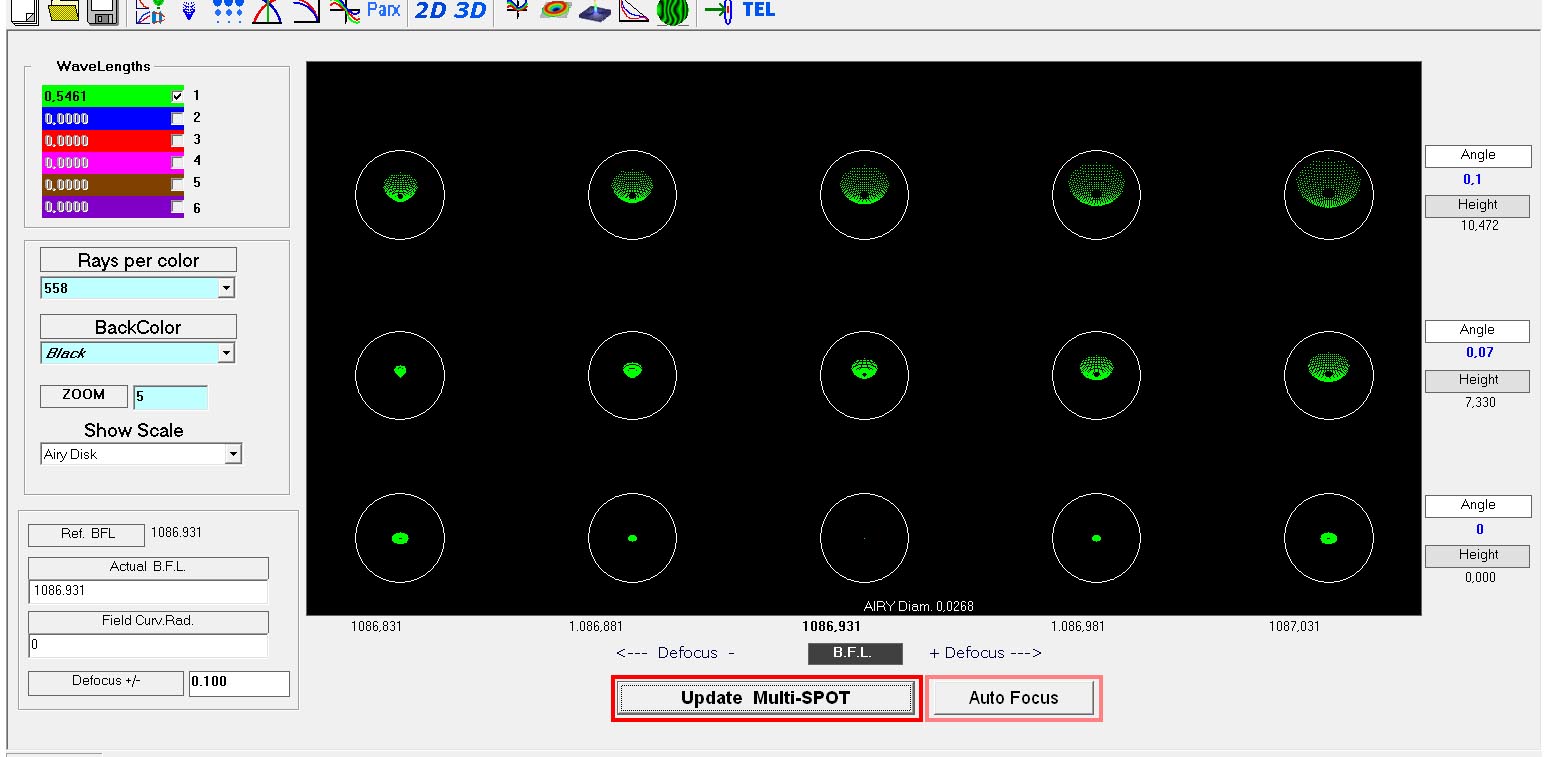
Ray tracing (ATMOS simulation). The white circle is the Airy disk, to scale. The image at the focal plane is always smaller than the Airy disk even at the edges of the field: the optical scheme is therefore diffraction limited over the entire field.
The main theorical aberrations present are the coma (elongated star) and the field curvature facing the sky (different dimensions of the spot, at the same distance from the focus). Astigmatism, however, is negligible.
Star test and Roddier test
The star test performed with the G Astronomik filter on Alphecca (alpha CrB, mv=2.2). Extrafocal on the left. Defocus 15 λ.
The SA is better assessed (rather than by the dimensions of the secondary) by the distribution of light on the two sides of the focus, very regular, with a very slight reinforcement on the first and last intrafocal ring (undercorrection). The overall figure appears smooth enough, considering the Supremax support, with regular Fresnel rings.
A slight astigmatism is present (8/14 - 11/17 hours), attributed to thermal effects or some tensioning in the mirrors.
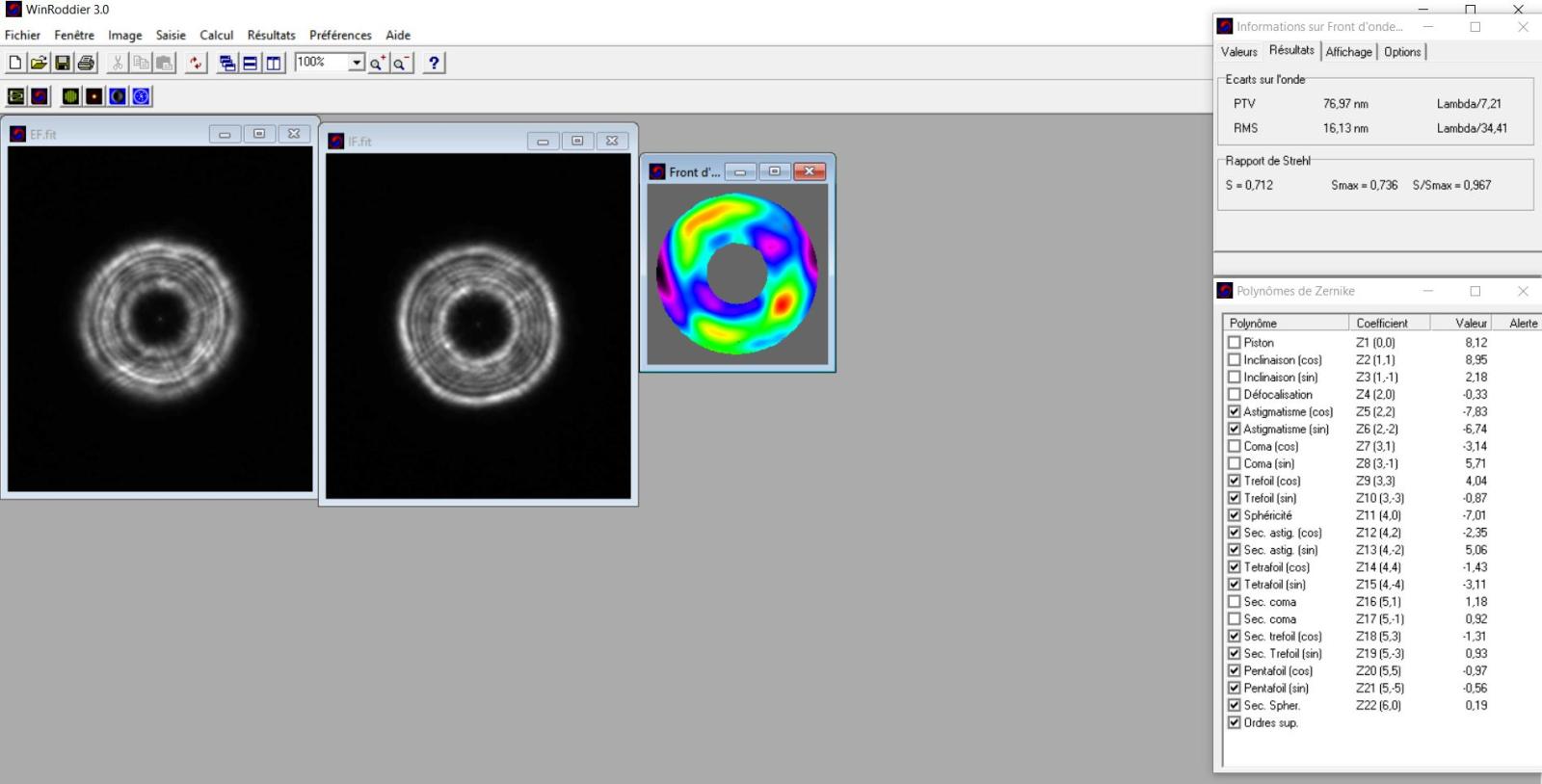
Two Roddier tests were performed on the previous star. The one shown here of 0.96 is the highest, and is in excellent agreement with the manufacturer's supplied interferometric test. The other test in different conditions gave SR=0.90, for an average of approximately SR=0.93.
Final thoughts
The classic Cassegrain is considered (at least on paper) the ideal instrument for high resolution. The very fast primary (generally parabolized at at least f/4, but proposed with more extreme focal ratios from the small and brave CFF) and the difficult hyperbolic secondary make it, necessarily, a not cheap telescope when compared with mass-market instruments of the same diameter, intended for enthusiasts who know what they want and don't want to compromise.
In a few years of use (from Aversa or Turin) I have sometimes obtained images that I would define as almost exceptional for a 30 cm scope. I attach a couple of examples (Venus clouds in UV, and Plato crater at filter B).
Unfortunately I made visual observations certainly less than I would have liked, and I do not attach detailed reports. However, the instrument gives very fine, razor-sharp images; in the Great Opposition of 2020 I managed to see Deimos distinctly, without black cardboard, only bringing the planet out of the field, from the urban sky of Aversa (Italy).
Currently (end of 2023) telescope price is 8,389 euros (CFF price list), VAT included. Dealer for Italy is Skypoint Srl.
